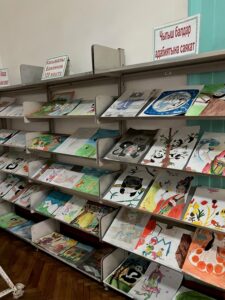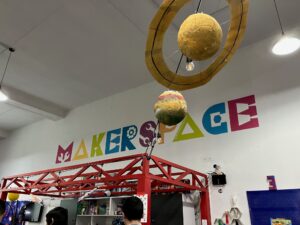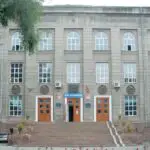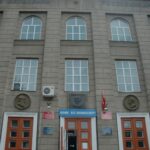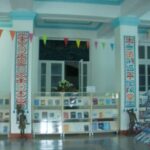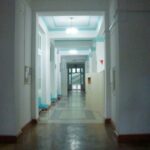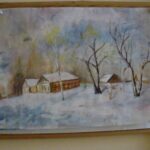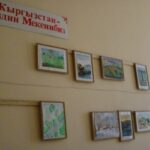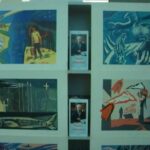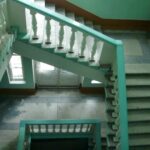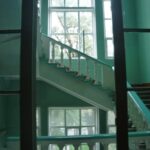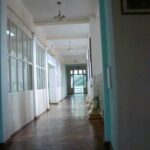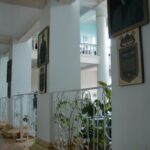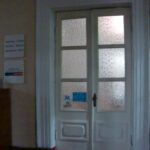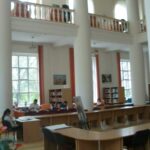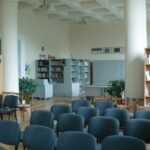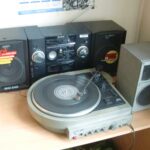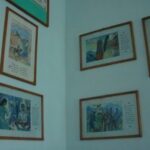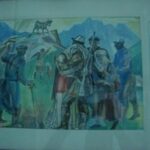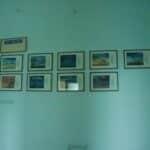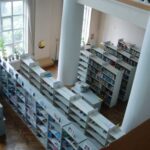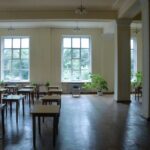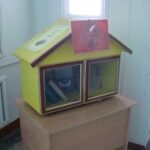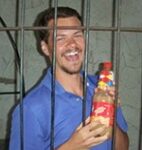The current building housing the K. Bayalinov Library for Children and Youth was built in 1984. It’s located at Ogonbayeva Ataya, 242, near the National Art Museum.
It currently holds about 6 million items. Although the facility is officially for children, many of their holdings are quite mature and will be of interest to researchers as well. These includes documents written in Kyrgyz using the Arabic script that was used at one point in Kyrgyz history, Soviet-era documents (when the script was converted to Cyrillic), and an entire section devoted to Kyrgyz development.
The library also provides a full range of internationally-oriented literature and periodicals. There is a section with books in over 40 other languages, a scientific periodicals section, and a daily periodicals section.
There are also multiple country-specific rooms, such as a French hall, German Room and American Corner. Each contains those countries’ classics in the original language, such as works by Jules Vernes, Franz Kafka, and John Steinbeck, respectively, in addition to serving as speaking-clubs. The supervisor of the German Room told me (Lily) that the library used to have a partnership with the Goethe Institute, which had donated a large collection of German-language literature. The American Corner is sponsored by the U.S. Embassy and houses a large selection of English language books, board games, a computer lab, and a meeting space.
- Children’s art at the Bayalinov Children’s Library in Bishkek, Kyrgyzstan
- Makerspace, sponsored in part by the US Department of State, at the Bayalinov Children’s Library in Bishkek, Kyrgyzstan.
- International literature at the Bayalinov Children’s Library in Bishkek, Kyrgyzstan.
I was told it used to be a common place to study for university students before the Internet and computers really took hold in Kyrgyzstan. Being a bit of a bookworm and curious to visit a place where many of the teachers from London School used to study, I stepped in. When you step into the foyer on the left hand side is a coat check (гардероб) for your bags and heavy winter coats. Then, immediately to the right of the window is a ticket counter. Here you can purchase a day pass or year-long pass. The day pass is 5 som (less than a dime) and they ask for your name which they write on a paper pass that you keep with you throughout the library. When you step into a specific room, there is usually a counter near the door that you leave the pass on which is stamped or signed by the official of that room, on the way out simply pick up your card and move on.
The library’s layout is fairly simple; each of the three floors has a central hall that extends from one end of the building to the other. Along the halls are the various library sections and reading rooms/areas. Some of them, sadly, were locked when I was there without any posted working hours. At both ends of the halls there are marble stair-cases painted a strange pastel green.
The first floor of the library has a children’s room, a Kyrgyzstan development resource center, a scientific periodicals section and attached reading room and a children’s room displaying recently painted children’s artwork next to the doorway.
The second floor appears to be the main floor. There is a large, open area with desks populated by university-aged students hunched over notebooks. The room has high ceilings, large windows, and paintings of great Kyrgyz heroes.
The main floor also features the German Room, American Corner, and a Maker Spaces. Through the American Corner, I have volunteered at the English speaking club. There are usually about thirty locals who attend, ranging from high schoolers to people past middle-age. I was told there was a cap on the number of people permitted to come, because during the last winter session between semesters there were few native English speakers in the city to help lead discussion groups. However, with an influx of new students from SRAS now volunteering, the group size may expand. We students have all found it to be a great opportunity to meet locals, who are super eager to give us tips about life here and often ask to exchange contact information.
The third floor is where one can find the art section, which also has a small meeting space and some interesting items like an older record player next to a boom-box. When I visited there, a komuz (a traditional Kyrgyz musical instrument) was also there. Also on this floor are sections devoted to periodicals, one room housed newspapers and another had magazines of all sorts to read.
On the way out of the library I was surprised to see two Little Free Libraries in the foyer, which work off the take-a-book-leave-a-book principle and are sprinkled across suburban towns in the U.S. Overall the library has a very welcoming atmosphere to it, and it was fun to observe the various language-classes and community events transpiring in nearly every room. If you are looking to volunteer in the community, the American Corners are generally good places to do so. They are generally looking for people to lead events, speak about American culture, or otherwise help out. You could also pick up an English book when home-sick or find a fun Russian book elsewhere in the library to practice your Russian skills.
Note: this resource was originally written in 2015 by SRAS student Ian Walker. It was updated in 2023 by SRAS student Lily Nemirovsky.
- The site that greets one when walking around.
- This is the room one immediately walks into, to the left is the ticket counter.
- First floor hall-w.ay
- Some children’s art from fairy-tales.
- Art inspired by Chingiz Aitmatov’s works
- The stairs.
- Second floor hall way.
- Also second floor hallway, on the pillars are the portraits of Kyrgyz heroes and the area behind them seems to be the largest central reading area.
- The entrance to the American Corner.
- The American Corner.
- The Art Resources Room
- Interesting music playing equipment found in the Art Resources Room.
- There were other pictures found in unused corners which seemed to tell a story of some sort, it was all in Kyrgyz though.
- A close-up of the drawings.
- Third floor hall-way.
- View from the third floor into large open area on the second floor.
- Second floor.
- First floor periodicals reading room.
- A mini-library near the entrance.



